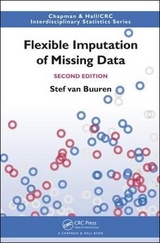
Flexible Imputation of Missing Data
Chapman & Hall/CRC (Verlag)
978-1-4398-6824-9 (ISBN)
- Titel erscheint in neuer Auflage
- Artikel merken
Flexible Imputation of Missing Data is supported by many examples using real data taken from the author's vast experience of collaborative research, and presents a practical guide for handling missing data under the framework of multiple imputation. Furthermore, detailed guidance of implementation in R using the author’s package MICE is included throughout the book.
Assuming familiarity with basic statistical concepts and multivariate methods, Flexible Imputation of Missing Data is intended for two audiences:
(Bio)statisticians, epidemiologists, and methodologists in the social and health sciences
Substantive researchers who do not call themselves statisticians, but who possess the necessary skills to understand the principles and to follow the recipes
This graduate-tested book avoids mathematical and technical details as much as possible: formulas are accompanied by a verbal statement that explains the formula in layperson terms. Readers less concerned with the theoretical underpinnings will be able to pick up the general idea, and technical material is available for those who desire deeper understanding. The analyses can be replicated in R using a dedicated package developed by the author.
Basics
Introduction
The problem of missing data
Concepts of MCAR, MAR and MNAR
Simple solutions that do not (always) work
Multiple imputation in a nutshell
Goal of the book
What the book does not cover
Structure of the book
Exercises
Multiple imputation
Historic overview
Incomplete data concepts
Why and when multiple imputation works
Statistical intervals and tests
Evaluation criteria
When to use multiple imputation
How many imputations?
Exercises
Univariate missing data
How to generate multiple imputations
Imputation under the normal linear normal
Imputation under non-normal distributions
Predictive mean matching
Categorical data
Other data types
Classification and regression trees
Multilevel data
Non-ignorable methods
Exercises
Multivariate missing data
Missing data pattern
Issues in multivariate imputation
Monotone data imputation
Joint Modeling
Fully Conditional Specification
FCS and JM
Conclusion
Exercises
Imputation in practice
Overview of modeling choices
Ignorable or non-ignorable?
Model form and predictors
Derived variables
Algorithmic options
Diagnostics
Conclusion
Exercises
Analysis of imputed data
What to do with the imputed data?
Parameter pooling
Statistical tests for multiple imputation
Stepwise model selection
Conclusion
Exercises
Case studies
Measurement issues
Too many columns
Sensitivity analysis
Correct prevalence estimates from self-reported data
Enhancing comparability
Exercises
Selection issues
Correcting for selective drop-out
Correcting for non-response
Exercises
Longitudinal data
Long and wide format
SE Fireworks Disaster Study
Time raster imputation
Conclusion
Exercises
Extensions
Conclusion
Some dangers, some do's and some don'ts
Reporting
Other applications
Future developments
Exercises
Appendices: Software
R
S-Plus
Stata
SAS
SPSS
Other software
References
Author Index
Subject Index
| Erscheint lt. Verlag | 27.4.2012 |
|---|---|
| Reihe/Serie | Chapman & Hall/CRC Interdisciplinary Statistics |
| Zusatzinfo | text is PMS 200+ Black; SEE NOTES 1st print - CORRECTION ARCHIVED; 26 Tables, black and white; 58 Illustrations, black and white |
| Sprache | englisch |
| Maße | 156 x 234 mm |
| Gewicht | 816 g |
| Themenwelt | Mathematik / Informatik ► Mathematik ► Computerprogramme / Computeralgebra |
| Naturwissenschaften ► Biologie | |
| ISBN-10 | 1-4398-6824-7 / 1439868247 |
| ISBN-13 | 978-1-4398-6824-9 / 9781439868249 |
| Zustand | Neuware |
| Haben Sie eine Frage zum Produkt? |
aus dem Bereich



